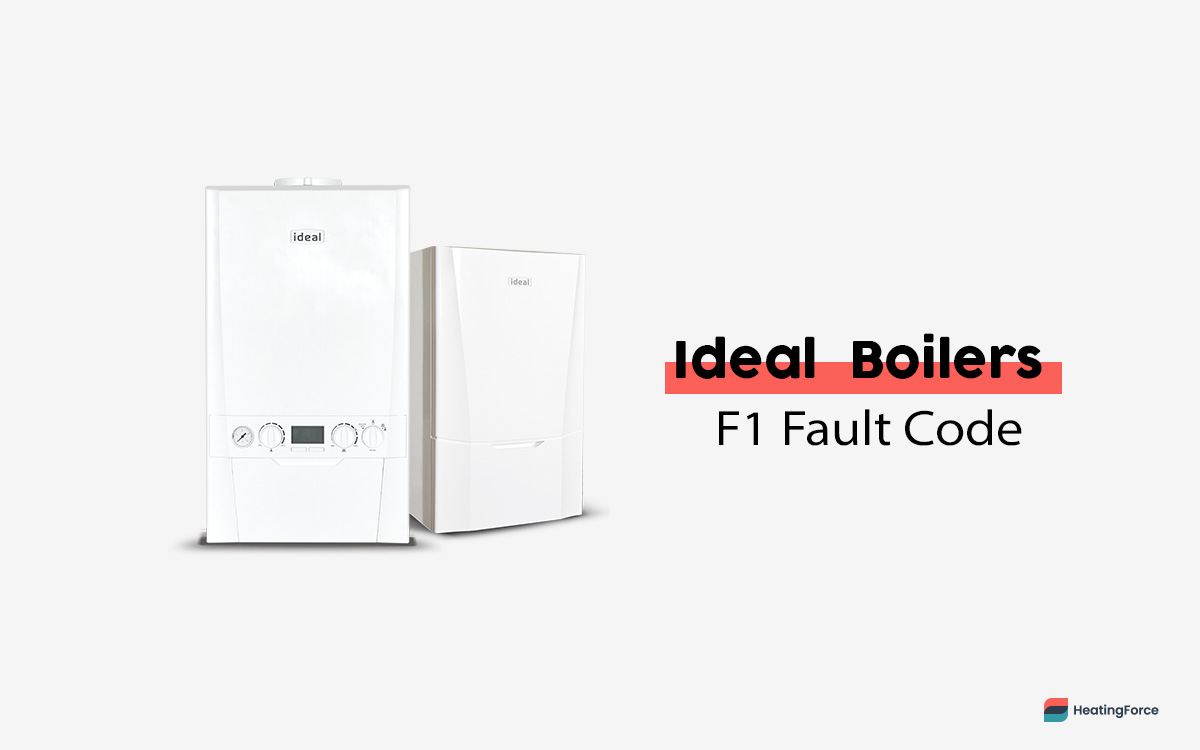Ideal F1 Fault Code Fix: What Does F1 Mean on an Ideal Boiler + How to Fix It
The F1 boiler fault is one of the most common Ideal boiler fault codes, appearing on multiple models, including the Logic combi (e.g. Ideal Logic Combi 30). But what is the Ideal F1 fault code fix? How can you solve this problem yourself at home? Keep reading to find out.

If your central heating system is throwing up this code — don’t despair. Although many other fault codes lead to a long-winded diagnostic process and a pricey fix, this shouldn’t be the case here.
Our quick guide below explains the Ideal F1 fault code fix means and will see your central heating system running like a dream again in no time flat. In general, if you see an F1 on your boiler, you should be able to correct the underlying issue without help. But, if in doubt, always speak to a Gas Safe engineer.
Get a fixed price for a new one on your screen here.
What Does the F1 Boiler Fault Code Mean?
The Ideal boiler F1 fault code means there is a lack of pressure in your heating system, most likely because there simply isn’t enough water.
If you see an F1 on a boiler, you may also see lights flashing on the front of your appliance. The boiler won’t work again until you raise the pressure and reset it.
Causes of the F1 Boiler Fault Code
In the simplest scenario, all you have to do is add water to the system via the filling loop.
However, if the system pressure keeps dropping, there could be a leak. You’ll need to fix the leak before you increase your boiler’s pressure, otherwise, your property/boiler could be subject to water damage.
So, we’d suggest flicking through our guide on how to fix the F1 boiler fault code below before you decide what to do next.
How to Fix the F1 Boiler Fault on a Boiler
Depending on the exact issue, you may need to contact a Gas Safe engineer. This is certainly the case for any step below that entails the boiler being taken apart.
-
Test the Pressure Sensor
If your boiler’s pressure gauge is sitting between 1-2 bar (1.5 bar is the ideal boiler pressure for an efficient heating system), then the pressure isn’t the problem. More likely, the pressure sensor is producing incorrect readings.
The water pressure sensor’s job is to tell the Printed Circuit Board (PCB) whether the pressure is too high or low. If it’s giving the PCB false signals, the boiler will display the F1 boiler fault code and stop working.
In the above scenario, your boiler engineer will want to test the water sensor and decide whether to replace it. The best boiler cover providers include the cost of such repairs in their policy, but if you haven’t got cover, you’ll have to pay for the new sensor and the labour and materials involved in the repairs.
-
Lack of Pressure, or Pressure Loss?
If the pressure gauge is reporting a low pressure (i.e. sensor isn’t the issue), you’ll need to determine whether the problem stems from a lack of pressure or a loss of pressure.
A lack of water pressure will require the boiler to be topped up with water via the filling loop (see how to increase boiler pressure below).
However, if your boiler loses pressure, it means the boiler is leaking water. You’ll want to get the leak fixed before topping up the boiler’s pressure, otherwise, you could have expensive repair bills for internal boiler components due to water damage, or even plaster/floorboards if the leak is coming from pipework.
A boiler should stay stable with the pressure gauge reading approximately 1.5 bar; below 0.5 bar, it’s going to stop working. So, is the boiler losing pressure after it’s topped up?
-
Finding Leaks
Naturally, the next step is to find leaks. Even the smallest leak means water and pressure loss over time.
Your heating engineer will systematically check things such as:
- Radiators and towel rails for pinholes
- Copper pipework for pinholes or loose joints
- The boiler’s pump and heat exchanger.
In most cases, the leak will come from one of the above. You must fix it before increasing your boiler’s pressure.
-
Increasing Boiler Pressure [And Bleeding Radiators]
The boiler will then need to be topped up, using the small braided hose beneath the boiler casing (the filling loop).
Monitor the pressure gauge as you increase boiler pressure — the ideal boiler pressure is 1.5 bar, which is what you’re aiming for (always check your owner’s manual to confirm this).
Note: As you fill up your heating system, air will enter. This essentially creates a blockage in your heating system, so it needs to be removed. You’ll need to top up the boiler and bleed radiators at the same time, so it’s worth getting a second pair of hands to help you during the process.
As you bleed the radiators, pressure will drop (so you’ll need to keep topping up via the filling loop) alongside bleeding them, until ALL air has escaped. We’ve created a guide covering how to bleed radiators here.
-
Clear The F1 Boiler Fault Code
So, you’ve found and fixed leaks, increased boiler pressure, and bled all radiators.
The final step to clear the F1 boiler fault code and get your boiler up and running again is to reset your boiler. Job done!
Ideal Boiler Problems
The Ideal boiler F1 code isn’t the only common issue with this boiler brand. In most scenarios, multiple error codes will show at once. When they don’t, there’s still a chance that there’s more than one problem.
If your boiler still isn’t fixed, jump over to our guide covering the most common Ideal boiler problems here.
And if you’re fed up of your old boiler and want a new one, check out our guide to new boiler costs here.
Alternatively, you can get Heatable’s quote for a new boiler on your screen now by filling in a quick anonymous questionnaire.
What’s Next?
That’s it! Hopefully, that is the Ideal F1 fault code fix you’ve been searching for. Your boiler should now be working without issue.
Still got a problem? Send us an email via our contact page and we’ll do our best to help you out.
